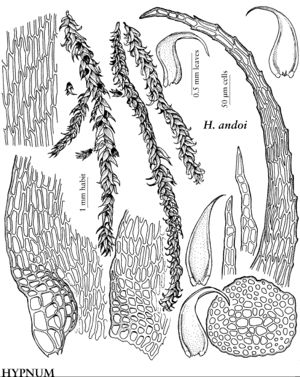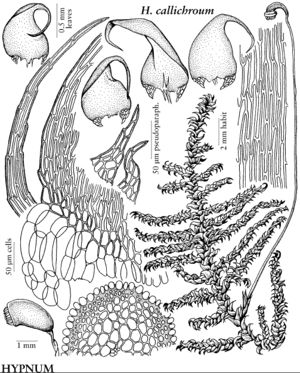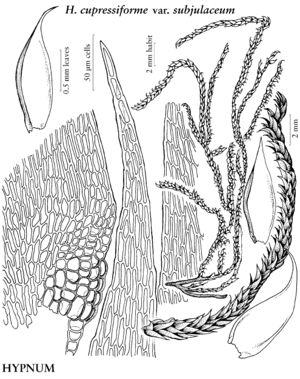Hypnum
Sp. Musc. Frond., 236, plate 59, figs. 8, 9.
plates 60–77. 1801.
| Taxon | Illustrator ⠉ | |
|---|---|---|
 | Hypnum andoi | Patricia M. Eckel |
 | Hypnum callichroum | Patricia M. Eckel |
 | Hypnum cupressiforme var. subjulaceum | Patricia M. Eckel |
| ... further results | ||
Plants small to large, in tufts or not, yellowish, green, or brown, glossy or dull. Stems creeping to erect, complanate-foliate or not, rarely subjulaceous, 1-pinnate or 2-pinnate or irregularly branched, branches not curled when dry; hyalodermis and central strand present or absent; pseudoparaphyllia filamentous to foliose. Stem and branch leaves similar, secund or falcate-secund, not undulate, broadly to narrowly ovate, widest beyond base, not to strongly plicate; base decurrent or not; margins sometimes recurved basally, usually plane distally, sinuate to entire proximally, toothed to entire distally; apex acuminate or acute; costa double or obscure, usually to 1/4 leaf length; alar cells often differentiated, quadrate, subquadrate, triangular, or hexagonal; laminal cells smooth; distal cells usually longer than 6: 1. Specialized asexual reproduction absent. Sexual condition autoicous, dioicous, or phyllodioicous; outer perichaetial leaves reflexed, inner leaves erect, ovate to lanceolate or subulate, apex slenderly acuminate. Seta yellowish to reddish. Capsule erect, inclined, or horizontal, long-cylindric to ovoid, usually curved, commonly contracted below mouth; annulus 1–3-seriate to scarcely differentiated; operculum conic to rounded-mammillate; peristome double; exostome teeth with external surface with distinct zigzag line and lamellae, finely cross-striolate basally, hyaline and papillose distally; endostome basal membrane high, segments ca. as high as teeth, carinate, cilia 1–3 or sometimes rudimentary. Calyptra naked. Spores round, smooth or finely papillose.
Distribution
Nearly worldwide, except Antarctica, temperate regions
Discussion
Species ca. 50 (22 in the flora).
Hypnum remains a repository for a number of discordant elements, some considered to belong to other families. The genus once included a high proportion of the pleurocarpous mosses. The generic concept accepted here contains some species probably not Hypnum, but it is a reasonably natural genus that can be recognized in the field, especially when examined with a hand lens. Gametophytic features are supreme in separation of species although the presence of sporophytes provides additional features.
Leafy plants of vegetative specimens may consist almost entirely of branches, with different but characteristic stem leaves unrepresented. This can happen when plants form turflike colonies or when stems disintegrate, leaving only branches. Plants in extreme environments, especially with respect to moisture, may be unusual; for instance, plants of deeply shaded or wet sites may be markedly attenuated. In the key, the following features define differences in size of gametophores: ‘small’ refers to stem leaves 1.2–1.5 mm and stems usually 1–2 cm and slender (related to the leaf size); ‘medium’ refers to stem leaves 1.5–3 mm and stems 2–4 cm; ‘large’ or ‘robust’ refers to stem leaves more than 3 mm and stems more than 4 cm.
Selected References
None.
Lower Taxa
Key
| 1 | Stems with hyalodermis usually present | > 2 |
| 1 | Stems with hyalodermis absent | > 10 |
| 2 | Hyalodermis absent, sometimes epidermis present, interrupted, especially at leaf decurrencies. | Hypnum fauriei |
| 2 | Hyalodermis present | > 3 |
| 3 | Stem leaves gradually tapering to insertion (except H. pratense); alar regions slightly differentiated | > 4 |
| 3 | Stem leaves curved to insertion (except H. lindbergii); alar regions usually well defined | > 6 |
| 4 | Stems complanate-foliate; leaves sometimes falcate, not strongly secund; apices broadly acute. | Hypnum pratense |
| 4 | Stems never complanate-foliate; leaves falcate- or circinate-secund; apices narrowly acuminate | > 5 |
| 5 | Plants small; stem leaves 1.3-1.5 × 0.4-0.5 mm; stems erect; plants in tufts; medial laminal cells 40-60(-70) µm; leaf margins weakly toothed toward apex. | Hypnum hamulosum |
| 5 | Plants medium-sized; stem leaves 1.5-2.8 × 0.4-0.6 mm; stems creeping; plants not in tufts; medial laminal cells 50-80(-90) µm; leaf margins serrate toward apex. | Hypnum subimponens |
| 6 | Plants small to medium-sized; stem leaves strongly curved to insertion; bases auriculate; alar regions with outermost cell walls not thinner. | Hypnum plicatulum |
| 6 | Plants small to large; stem leaves not, weakly, or sometimes strongly curved to insertion; bases decurrent or not; alar regions with outermost cell walls thinner | > 7 |
| 7 | Plants small; stem leaves broadly ovate-lanceolate; alar cells gradually enlarged; bases not decurrent. | Hypnum holmenii |
| 7 | Plants medium-sized to large, rarely small; stem leaves ovate, ovate-lanceolate, or oblong-ovate; alar cells abruptly enlarged; bases decurrent | > 8 |
| 8 | Bases weakly decurrent; stems red-brown to nearly black. | Hypnum dieckei |
| 8 | Bases decurrent; stems yellow, green, or reddish brown, brown with age | > 9 |
| 9 | Stems usually reclining (procumbent to ascending); leaf acumina slender; margins serrulate at apex; stems yellow or green. | Hypnum callichroum |
| 9 | Stems often suberect to creeping; leaf acumina slender or broad; margins entire to bluntly serrate at apex; stems brown with age. | Hypnum lindbergii |
| 10 | Stem leaf bases auriculate, sometimes only on one side | > 11 |
| 10 | Stem leaf bases not or rarely slightly auriculate | > 13 |
| 11 | Stem leaf acumina long-attenuate; alar cells few, 2-5 in marginal row. | Hypnum circinale |
| 11 | Stem leaf acumina broad or tapering; alar cells few or more than 20 | > 12 |
| 12 | Alar cells few, regions often excavate; plants light green to yellow-green, glossy; stems sparsely branched. | Hypnum curvifolium |
| 12 | Alar cells more than 20, regions not excavate; plants rusty brown to golden brown or occasionally dark green, dull; stems densely branched. | Hypnum procerrimum |
| 13 | Leaf bases decurrent (when stripped from stem often bearing 1 or more elongate decurrent cells on margin) | > 14 |
| 13 | Leaf bases not or weakly decurrent (when stripped from stem usually not bearing elongate decurrent cells) | > 15 |
| 14 | Pseudoparaphyllia with margins entire. | Hypnum fauriei |
| 14 | Pseudoparaphyllia with margins incised. | Hypnum imponens |
| 15 | Alar regions extensive, triangular, of 5+ vertical rows of cells, elongate basalmost cells few or absent | > 16 |
| 15 | Alar regions small, of 1-3 vertical rows of cells, elongate basalmost cells 1-3 | > 22 |
| 16 | Pseudoparaphyllia broadly foliose. | Hypnum vaucheri |
| 16 | Pseudoparaphyllia filamentous or lanceolate | > 17 |
| 17 | Stem leaf margins recurved basally to 2/3 leaf length or longer, occasionally plane; sexual condition autoicous. | Hypnum recurvatum |
| 17 | Stem leaf margins recurved near base or plane; sexual condition dioicous | > 18 |
| 18 | Plants small; branch leaves (0.8-)1-1.4 × 0.2-0.4 mm | > 19 |
| 18 | Plants small to medium-sized; branch leaves larger than (0.8-)1-1.4 × 0.2-0.4 mm | > 20 |
| 19 | Stem leaves falcate-secund; margins sharply serrulate at apex. | Hypnum andoi |
| 19 | Stem leaves weakly or not falcate; margins entire to serrulate at apex. | Hypnum cupressiforme |
| 20 | Plants large; branch leaves 1.4-2.5 × 0.5-0.7 mm. | Hypnum cupressiforme |
| 20 | Plants medium-sized; branch leaves 1.4-2 × 0.4-0.5 mm | > 21 |
| 21 | Plants rusty green, golden green, yellow-green, or pale green; stems not complanate-foliate; leaves strongly imbricate. | Hypnum cupressiforme |
| 21 | Plants pale green; stems strongly complanate-foliate; leaves loosely imbricate. | Hypnum jutlandicum |
| 22 | Pseudoparaphyllia filamentous to lanceolate | > 23 |
| 22 | Pseudoparaphyllia foliose or lanceolate | > 25 |
| 23 | Plants pale green; stems strongly complanate-foliate; leaves loosely imbricate. | Hypnum jutlandicum |
| 23 | Plants pale green, yellowish, rusty green, or golden green; stems not complanate-foliate; leaves closely imbricate | > 24 |
| 24 | Stem leaf margins sharply serrulate at apex; plants usually on vertical surfaces. | Hypnum andoi |
| 24 | Stem leaf margins serrulate or nearly entire at apex; plants usually on horizontal surfaces. | Hypnum cupressiforme |
| 25 | Alar cells dark brown, regions excavate; laminal cell walls pitted throughout; plants reddish to yellowish brown; usually in seepage sites. | Hypnum bambergeri |
| 25 | Alar cells, if pigmented, usually reddish to yellowish, if excavate, whole alar region involved; laminal cell walls pitted only near base; plants pale rusty brown to golden green; usually in well-drained to dry sites | > 26 |
| 26 | Plants small, rarely medium-sized; sexual condition autoicous or dioicous; alar cells subopaque or not pigmented | > 27 |
| 26 | Plants medium-sized to large; sexual condition dioicous or phyllodioicous; alar cells pigmented or not | > 28 |
| 27 | Stem leaf margins serrate distally; sexual condition autoicous; epiphytic or on rotten wood. | Hypnum pallescens |
| 27 | Stem leaf margins entire at apex; sexual condition dioicous; usually terrestrial and often on calcareous rock. | Hypnum revolutum |
| 28 | Alar cells at basal margin hyaline, enlarged. | Hypnum vaucheri |
| 28 | Alar cells at basal margin red-pigmented, swollen | > 29 |
| 29 | Pseudoparaphyllia lanceolate or ovate, margins not incised. | Hypnum fujiyamae |
| 29 | Pseudoparaphyllia lanceolate or foliose, margins usually incised. | Hypnum imponens |